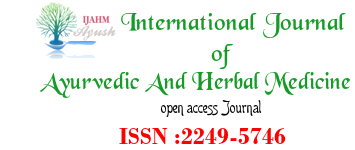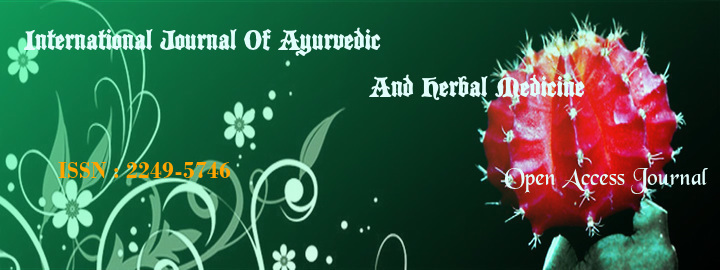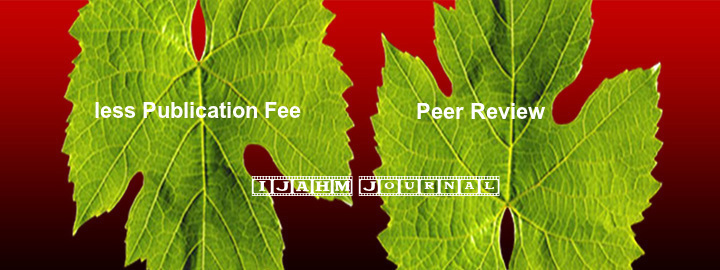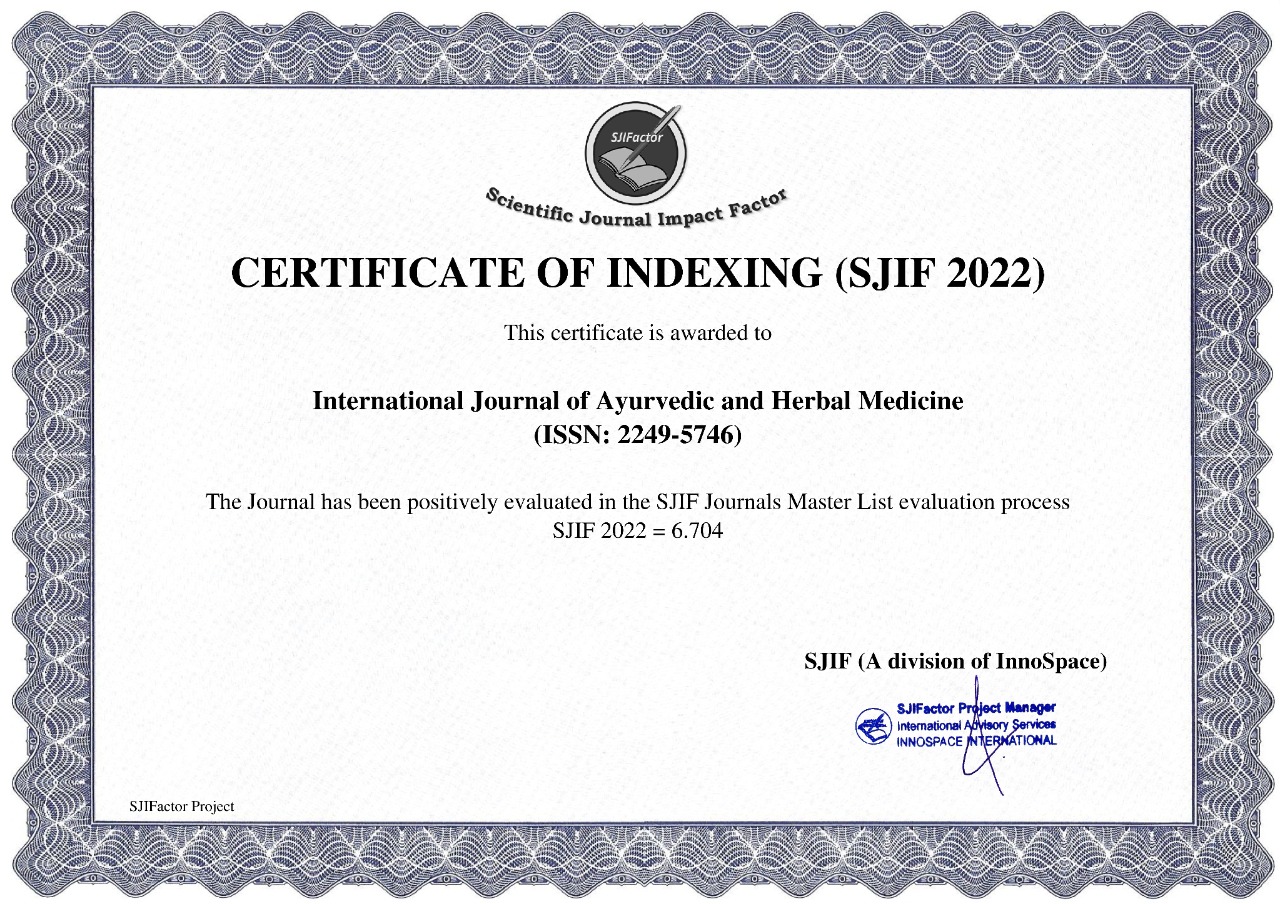


1 Handore A.V. and 2* Khandelwal S. R.
1, 2 Department of Microbiology, HPT Arts and RYK Science College, Nashik -422005, MS, India.
ABSTRACT:
Vitisvinifera is one of the important economic fruit crop having widespread application in variety of health diseases and disorders. Since anancient times, Vitisvineferaissignificantly used in Ayurvedadue presence of bioactivepolyphenols..Although, itsfruits and seedshas been used in various AyurvedicRasayandrugs and formulations, scanty research has been carried out on presence of polyphenols in aerial parts of this plants and their study asa remedial agent.The present study deals with identification and determination of bioactive polyphenols in Black and White(Green) cultivar of V.vinefera .Organic extracts were prepared by soaking the dry powder into 90% Methanol. Qualitative analysis of different parts of V. vinefera viz. leaf lamina, stem and petiole was carried out by phytochemical screening. In the quantitative analysis, Folin-Ciocalteau method was used to determine total phenolic content whereas, total flavonoid content was estimated by aluminum chloride colorimetric assay. Free radical scavenging activity of extract wascarried out by DPPH assay andaccumulation of bioactive compounds in different regions was studied by anatomical analysis. Results of phytochemical screening of both cultivars showed presence of bioactive polyphenols viz. flavonoids, ellagic acid, tanninalong with otherphenolic compoundsin high abundance.In the white cultivartotal phenolic content of petiole was found to be highest (1.44± 0.19 mg/g GAE) whereas,leaves showed lowest content (0.38± 0.11mg/g GAE).In the black cultivar, leaves showed highest content of total phenols (1.57± 0.05 mg/g GAE) and stem showed lowest content i.e. 0.41± 0.07 mg/g GAE.Total flavonoid content of petiole of white cultivar was observed to behighest (0.15 ±0.05mg/g quercetin equivalent)as compared to leaves and stem.Whereas, leaves of black cultivar showed almost high content of flavonoid i.e. 0.26 ±0.09mg/g quercetin equivalent.Order of radical scavenging activity forboth cultivar was,petiole(79.24%)>stem(75.10%)>leaflamina(72.37%)and stem(83.03%)> petiole(80.40 %)>leaflamina(62.42%) respectively.Amount of flavonoids (quercetin) in petiole of white cultivar was found to be 3.27 ppm by HPLC analysis.Findings of the current study revealed that aerial parts of V. vineferaare rich source of various bioactive polyphenolic compounds with promising therapeutic potential. Therefore irrespective to economic boundaries, these aerial parts can be efficiently usedin for phyto-therapeutic applications.
Keywords- Vitisvinefera ,Aerial parts, Bioactive polyphenols, Antioxidant ,Phyto-therapeutic
Reference
1. David V., Ana R., Giulia C, Maria Jose O. and Jeremy P. E.,Polyphenols and Human Health: Prevention of Disease and Mechanisms of Action,Nutrients 2010, (2):1106-1131
2. Ahmad, N., Adhami V.M., Afaq F., Feyes D.K., and MukhtarH.. Resveratrol causes WAF-1/p21- mediated G1-phase arrest of cell cycle and induction of apoptosis in human epidermoid carcinoma A431. Cells. 2001.(7): 1466–1473.
3. Adhami, V.M., Afaq F., and Ahmad N. Involvement of the retinoblastoma (pRb)-E2F/DP pathway during antiproliferative effects of resveratrol in human epidermoid carcinoma (A431) cells. Biochem. Biophys. Res. Commun,2001.(288):579–585.
4. Bors, W., Heller W., Michel C., and Saran M.. Flavonoids as antioxidants: determination of radical scavenging efficiencies. In: Methods in Enzymology, vol. 186. Academic Press, New York, 1990:343–355.
5. Doshi, P., Adsule P., and BanerjeeK.. Phenolic composition and antioxidant activity in grapevine parts and berries (Vitisvinifera L.) cvKishmishChornyi (Sharad Seedless) during maturation. Int. J. Food Sci. Technol,2006.(41): 1–9.
6. Xia, EQ., Deng, GF., Guo, YJ., Li, HB, Biological Activities of Polyphenols from Grapes, Int J MolSci, 11 ,2010:622–646
7. Agarwal, C, Veluri, R., Kaur, M., Chou, SC., Thompson, JA., Agarwal, R., Fractionation of high molecular weight tannins in grape seed extract and identification of procyanidin B2 – 3, 3’-di-O- gallalte as a major active constituent causing growth inhibition and apoptotic death of DUI 45 human prostate carcinoma cells, Carcinogenesis, 2007,(28):1478 – 1484.
8. Peng, N., Clark, JT., Prasain, J., Kim, H., White, CR., Wyss, JM., Antihypertensive and cognitive effects of grape polyphenols in estrogen-depleted, female, spontaneously hypertensive rats, Am J PhysiolRegulIntegr Comp Physiol, 2005, 289(3):771-775
9. Soobrattee, MA.,Neergheena, VS., Luximon-Rammaa, A., Aruomab, OI., Bahoruna, T, Phenolics as potential antioxidant therapeutic agents: Mechanism and actions, Mutation Research Fundamental and Molecular Mutagen, 2005.(579):200–213.
10. Dell A., M., Galli, GV., Vrhovsek, U., Mattivi, F., Bosisio, E, In vitro inhibition of human cGMP-specific phosphodiesterase-5 by polyphenols from red grapes, J of Agricultural and Food Chemistry ,2005,(53) :1960–1965
11. Marušic, R. LjekovitimB, Through herbal medicine to health. Milac, M.(ed.), Zagreb: Mladost,1990:358
12. Sabiha S., Aftab M. Ahmad, M. Asif, MohdA.andIbne S., Physicochemical and phytochemical standardization of berries of Myrtuscommunis Linn, J Pharm Bioallied Sci. 2012,.4(4) :322–326
13. BhandaryS. K.., KumariS. N. ,Bhat V. S. , K.PSharmila. , Bekal M. P., Preliminary Phytochemical Screening Of Various Extracts Of PunicaGranatumPeel,Whole Fruit And Seeds ,Nujhs2012, 2, (4):34-38
14. Rimjhim S., Kumari N. and. Jainendra K, Preliminary Phytochemical Screening of Methanolic Extract of Clerodendroninfortunatum, IOSR Journal of Applied Chemistry, 2014,(7):110-13
15. Usman H, Abdulrahman F I, and Usman A, Qualitative Phytochemical Screening and In Vitro Antimicrobial Effects of Methanol Stem Bark Extract of FicusThonningii (Moraceae), Afr. J. Trad. CAM. 2009,6 (3): 289 - 295
16. Zheng, W., Wang, Y.S, Antioxidant Activity and Phenolic Compounds in Selected Herbs. J. Agric. Food Chem. 2001,(49):5165-5170
17. Zhishen J, Mengcheng T and Jianming W, The determination of flavonoid contents in mulberry and their scavenging effects on superoxide radicals. Food Chemistry. 1999, (64):555-559
SannigrahiaSa., MazuderU..K., PalcD. K., ParidaaS.andJainaS., Antioxidant Potential of Crude Extract and Different Fractions of EnhydrafluctuansLour, Iranian Journal of Pharmaceutical Research 2010, 9 (1): 75-82
index























